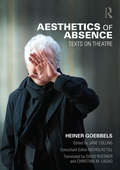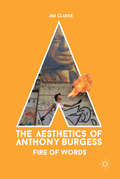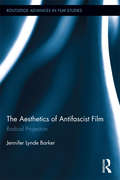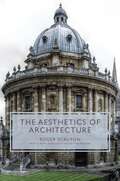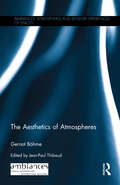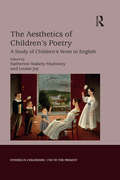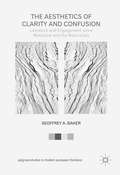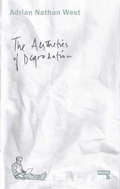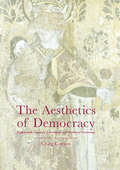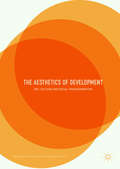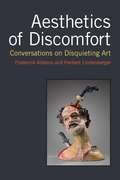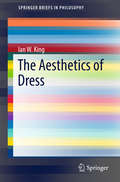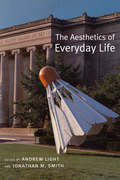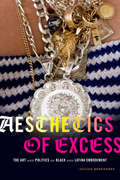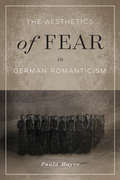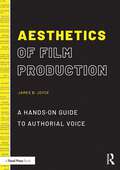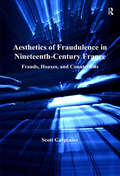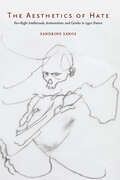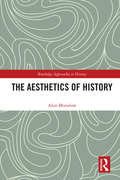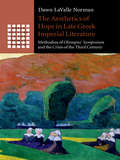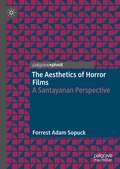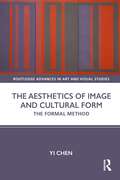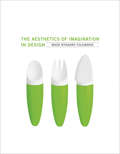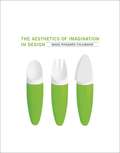- Table View
- List View
Aesthetics of Absence: Texts on Theatre
by Heiner GoebbelsAesthetics of Absence presents a significant challenge to the many embedded assumptions and hierarchical structures that have become ‘naturalised’ in western theatre production. This is the first English translation of a new collection of writings and lectures by Heiner Goebbels, the renowned German theatre director, composer and teacher. These writings map Goebbels’ engagement with ‘Aesthetics of Absence’ through his own experience at the forefront of innovative music-theatre and performance making. In this volume, Goebbels reflects on works created over a period of more than 20 years staged throughout the world; introduces some of his key artistic influences, including Robert Wilson and Jean-Luc Godard; discusses the work of his students and ex-students, the collective Rimini Protokoll; and sets out the case for a radical rethinking of theatre and performance education. He gives us a rare insight into the rehearsal process of critically acclaimed works such as Eraritjaritjaka and Stifters Dinge, explaining in meticulous detail the way he weaves an eclectic range of references from fine art, theatre, literature, politics, anthropology, contemporary and classical music, jazz and folk, into his multi-textured music-theatre compositions. As an artist who is prepared to share his research and demystify the processes through which his own works come into being, as a teacher with a coherent pedagogical strategy for educating the next generation of theatre-makers, in this volume, Goebbels brings together practice, research and scholarship.
The Aesthetics of Anthony Burgess
by Jim ClarkeThe book is the first full-length text on Anthony Burgess's fiction in a generation, and offers a radical and innovative way of understanding the extensive literary achievements of one of the twentieth century's most innovative authors. This book explores Burgess's dazzlingly diverse range of novels through the one key theme which links them all - the artistic process itself. Borrowing from Nietzsche's aesthetic dichotomy of Apollo and Dionysus, the book uncovers the protracted evolution of Burgess's fiction and offers a unifying theory which links his early postcolonial fiction chronologically, via his modernist experiments like A Clockwork Orange and Nothing Like The Sun, to his late classics Mozart and the Wolfgang and A Dead Man in Deptford. This volume clarifies Burgess's seminal role as both late modernist and early postmodernist, and lucidly unveils the legacy of England's most mercurial novelist.
The Aesthetics of Antifascist Film: Radical Projection (Routledge Advances in Film Studies)
by Jennifer Lynde BarkerThrough a series of detailed film case histories ranging from The Great Dictator to Hiroshima mon amour to The Lives of Others, The Aesthetics of Antifascist Film: Radical Projection explores the genesis and recurrence of antifascist aesthetics as it manifests in the WWII, Cold War and Post-Wall historical periods. Emerging during a critical moment in film history—1930s/1940s Hollywood— cinematic antifascism was representative of the international nature of antifascist alliances, with the amalgam of film styles generated in émigré Hollywood during the WWII period reflecting a dialogue between an urgent political commitment to antifascism and an equally intense commitment to aesthetic complexity. Opposed to a fascist aesthetics based on homogeneity, purity and spectacle, these antifascist films project a radical beauty of distortion, heterogeneity, fragmentation and loss. By juxtaposing documentation and the modernist techniques of surrealism and expressionism, the filmmakers were able to manifest a non-totalizing work of art that still had political impact. Drawing on insights from film and cultural studies, aesthetic and ethical philosophy, and socio-political theory, this book argues that the artistic struggles with political commitment and modernist strategies of representation during the 1930s and 40s resulted in a distinctive, radical aesthetic form that represents an alternate strand of post-modernism.
The Aesthetics of Architecture
by Roger ScrutonA landmark account of architectural theory and practice from acclaimed philosopher Roger ScrutonArchitecture is distinguished from other art forms by its sense of function, its localized quality, its technique, its public and nonpersonal character, and its continuity with the decorative arts. In this important book, Roger Scruton calls for a return to first principles in contemporary architectural theory, contending that the aesthetic of architecture is, in its very essence, an aesthetic of everyday life. Aesthetic understanding is inseparable from a sense of detail and style, from which the appropriate, the expressive, the beautiful, and the proportionate take their meaning. Scruton provides incisive critiques of the romantic, functionalist, and rationalist theories of design, and of the Freudian, Marxist, and semiological approaches to aesthetic value.In a new introduction, Scruton discusses how his ideas have developed since the book's original publication, and he assesses the continuing relevance of his argument for the twenty-first century.
The Aesthetics of Atmospheres (Ambiances, Atmospheres and Sensory Experiences of Spaces)
by Gernot BöhmeInterest in sensory atmospheres and architectural and urban ambiances has been growing for over 30 years. A key figure in this field is acclaimed German philosopher Gernot Böhme whose influential conception of what atmospheres are and how they function has been only partially available to the English-speaking public. This translation of key essays along with an original introduction charts the development of Gernot Böhme's philosophy of atmospheres and how it can be applied in various contexts such as scenography, commodity aesthetics, advertising, architecture, design, and art. The phenomenological analysis of atmospheres has proved very fruitful and its most important, and successful, application has been within aesthetics. The material background of this success may be seen in the ubiquitous aestheticization of our lifeworld, or from another perspective, of the staging of everything, every event and performance. The theory of atmospheres becoming an aesthetic theory thus reveals the theatrical, not to say manipulative, character of politics, commerce, of the event-society. But, taken as a positive theory of certain phenomena, it offers new perspectives on architecture, design, and art. It made the spatial and the experience of space and places a central subject and hence rehabilitated the ephemeral in the arts. Taking its numerous impacts in many fields together, it initiated a new humanism: the individual as a living person and his or her perspective are taken seriously, and this fosters the ongoing democratization of culture, in particular the possibility for everybody to participate in art and its works.
The Aesthetics of Children's Poetry: A Study of Children's Verse in English (Studies in Childhood, 1700 to the Present)
by Katherine Wakely-Mulroney Louise JoyThis collection gives sustained attention to the literary dimensions of children’s poetry from the eighteenth century to the present. While reasserting the importance of well-known voices, such as those of Isaac Watts, William Blake, Lewis Carroll, Christina Rossetti, A. A. Milne, and Carol Ann Duffy, the contributors also reflect on the aesthetic significance of landmark works by less frequently celebrated figures such as Richard Johnson, Ann and Jane Taylor, Cecil Frances Alexander and Michael Rosen. Scholarly treatment of children’s poetry has tended to focus on its publication history rather than to explore what comprises – and why we delight in – its idiosyncratic pleasures. And yet arguments about how and why poetic language might appeal to the child are embroiled in the history of children’s poetry, whether in Isaac Watts emphasising the didactic efficacy of “like sounds,” William Blake and the Taylor sisters revelling in the beauty of semantic ambiguity, or the authors of nonsense verse jettisoning sense to thrill their readers with the sheer music of poetry. Alive to the ways in which recent debates both echo and repudiate those conducted in earlier periods, The Aesthetics of Children’s Poetry investigates the stylistic and formal means through which children’s poetry, in theory and in practice, negotiates the complicated demands we have made of it through the ages.
The Aesthetics of Clarity and Confusion
by Geoffrey A. BakerWhat should literature with political aims look like? This book traces two rival responses to this question, one prizing clarity and the other confusion, which have dominated political aesthetics since the late nineteenth century. Revisiting recurrences of the avant-garde experimentalism versus critical realism debates from the twentieth century, Geoffrey A. Baker highlights the often violent reductions at work in earlier debates. Instead of prizing one approach over the other, as many participants in those debates have done, Baker focuses on the manner in which the debate itself between these approaches continues to prove productive and enabling for politically engaged writers. This book thus offers a way beyond the simplistic polarity of realism vs. anti-realism in a study that is focused on influential strands of thought in England, France, and Germany and that covers well-known authors such as Zola, Nietzsche, Arnold, Mann, Brecht, Sartre, Adorno, Lukács, Beauvoir, Morrison, and Coetzee.
The Aesthetics of Degradation
by Adrian Nathan WestPornography keeps getting more extreme. Manufacturers, defenders and consumers of porn rely on a mix of wilful ignorance and bad faith to avoid serious discussion. When we do talk about violence against women in the porn world, the debate all too often becomes technical, complicated by legalities and outrage.But what are the moral and psychological consequences of the mercantilization of abuse?In this studied and ruthless examination of the place of pornography in contemporary life, translator and critic Adrian Nathan West treads dangerous literary and social ground, transcending cliches about free expression and the demands of the market to look at the moral discomfort of violent pornography from the perspective of the viewer.Collapsing distinctions between novel, memoir, and essay, this book will not make for light reading. But at its core is an extraordinarily brave and honest concern for the women and men who have been hurt in the name of sexual gratification.
The Aesthetics of Democracy
by Craig CarsonThis book offers an original and interdisciplinary interpretation of the relation between aesthetics and modern liberal democracy, uniting the fields of art theory with the democratic political philosophy and modern liberal economic theory. The central argument of the books offers an explanation of the theoretical limitations of the contemporary discourse concerning "political art," while at the same time illustrating historically how the European and American discourse of modern democracy and political economy developed an explicit stance against the conflation of art and politics. Exposing the unstated presuppositions about our modern liberal democracy, Craig Carson opens a new field of inquiry concerning the role of art, media, and televisual "theater" central to modern politics.
The Aesthetics of Development
by John Clammer Ananta Kumar GiriThrough a unique range of theoretical and practical case studies, this collection considers the relationship between the arts (understood as the visual arts, crafts, theatre, dance, and literature) and development, creating both a bridge between them that is rarely explored and filling in concrete ways the content of the "culture" part of the equation "culture and development". It includes manifestations of culture and the ways in which they relate to development, and in turn contribute to such pressing issues as poverty alleviation, concern for the environment, health, empowerment, and identity formation. It shows how the arts are an essential part of the concrete understanding of culture, and as such a significant part of development thinking - including the development of culture, and not only of culture as an instrumental means to promote other development goals.
Aesthetics Of Discomfort: Conversations On Disquieting Art
by Frederick Luis Aldama Herbert S. LindenbergerThrough a series of provocative conversations, Frederick Luis Aldama and Herbert Lindenberger-who have written widely on literature, film, music, and art-locate a place for the discomforting and the often painfully unpleasant within aesthetics. The conversational format allows them to travel informally across many centuries and many art forms. They have much to tell one another about the arts since the advent of modernism soon after 1900-the nontonal music, for example, of the Second Vienna School, the chance-directed music and dance of John Cage and Merce Cunningham, the in-your-faceness of such diverse visual artists as Francis Bacon, Pablo Picasso, Willem de Kooning, Egon Schiele, Otto Dix, and Damien Hirst. They demonstrate as well a long tradition of discomforting art stretching back many centuries, for example, in the Last Judgments of innumerable Renaissance painters, in Goya's so-called "black" paintings, in Wagner's Tristan chord, and in the subtexts of Shakespearean works such as King Lear and Othello. This book is addressed at once to scholars of literature, art history, musicology, and cinema. Although its conversational format eschews the standard conventions of scholarly argument, it provides original insights both into particular art forms and into individual works within these forms. Among other matters, it demonstrates how recent work in neuroscience may provide insights in the ways that consumers process difficult and discomforting works of art. The book also contributes to current aesthetic theory by charting the dialogue that goes on-especially in aesthetically challenging works-between creator, artifact, and consumer. Book jacket.
The Aesthetics of Dress (SpringerBriefs in Philosophy)
by Ian W. KingThis book explores the relationships between how the body appears and feels in everyday life through aesthetics. The recent shift away from Kantian aesthetics towards a more enacted route places at its core the realization that the world is experienced as possibilities for action, and critical to this understanding is how the body’s movement generates multiple pre-linguistic experiences and meaning. This route therefore realizes the importance of the body’s role in working in conjunction with cognition in generating these experiences. Nevertheless, this attention has predominantly focused on how the body ‘feels’ through engagement, rather than how it appears. This might be problematic as it is essential to appreciate that the body is not naked in everyday life, and therefore through dress we look to restore the balance between appearance and feel. <P><P> We ‘dress’ our bodies to communicate – to express our confidence (or not), identity, status, aspirations, affiliations etc. We dress according to the situation/audience etc. It might be to attract attention, to protect or to hide the body. It might be to accentuate height, or religious belief, or simply to shock or conform. Essentially, it is not simply clothing that we wear that achieves this – for example, hair, makeup, jewellery, handbags, shoes, piercings, tattoos – cumulatively these constitute how we ‘dress’ our bodies. Thus, the appearance (as well as the feel) of the body is significant if we are to appreciate an enacted approach to aesthetics.
The Aesthetics of Everyday Life (Spaces, Places And Environments Ser.)
by Andrew Light Jonathan SmithThe aesthetics of everyday life, originally developed by Henri Lefebvre and other modernist theorists, is an extension of traditional aesthetics, usually confined to works of art. It is not limited to the study of humble objects but is rather concerned with all of the undeniably aesthetic experiences that arise when one contemplates objects or performs acts that are outside the traditional realm of aesthetics. It is concerned with the nature of the relationship between subject and object.One significant aspect of everyday aesthetics is environmental aesthetics, whether constructed, as a building, or manipulated, as a landscape. Others, also discussed in the book, include sport, weather, smell and taste, and food.
Aesthetics of Excess: The Art and Politics of Black and Latina Embodiment
by Jillian HernandezHeavy makeup, gaudy jewelry, dramatic hairstyles, and clothes that are considered cheap, fake, too short, too tight, or too masculine: working-class Black and Latina girls and women are often framed as embodying "excessive" styles that are presumed to indicate sexual deviance. In Aesthetics of Excess Jillian Hernandez examines how middle-class discourses of aesthetic value racialize the bodies of women and girls of color. At the same time, their style can be a source of cultural capital when appropriated by the contemporary art scene. Drawing on her community arts work with Black and Latina girls in Miami, Hernandez analyzes the art and self-image of these girls alongside works produced by contemporary artists and pop musicians such as Wangechi Mutu, Kara Walker, and Nicki Minaj. Through these relational readings, Hernandez shows how notions of high and low culture are complicated when women and girls of color engage in cultural production and how they challenge the policing of their bodies and sexualities through artistic authorship.
The Aesthetics of Fear in German Romanticism (McGill-Queen's Studies in the History of Ideas #77)
by Paola MayerEnlightenment – both the phenomenon specific to the eighteenth century and the continuing trend in Western thought – is an attempt to dispel ignorance, achieve mastery of a potentially hostile environment, and contain fear of the unknown by promoting science and rationality. Enlightenment is often accompanied and challenged by countercultures such as German Romanticism, which explored the nature of fear and deployed it as a corrective to the excesses of rationalism. The Aesthetics of Fear in German Romanticism uncovers the formative role this movement played in the development of dark or negative aesthetics. Recovering a missing chapter in the history of the aesthetics of fear, Paola Mayer illustrates that Romanticism was a crucial transitional phase between the eighteenth-century sublime and the early twentieth-century uncanny. Mayer puts literature and philosophy in dialogue, examining how German Romantic literature employed narratives of fear to radicalize and then subvert the status quo in society, culture, and science. She traces the development of this aesthetic from its inception with pre-Romantics such as Jean Paul Richter to its end in Joseph von Eichendorff's critical retrospective, and juxtaposes canonical authors such as E.T.A. Hoffmann – the father of the modern fantastic – with writers who have previously been ignored. Today, when the dark side of science looms in the foreground, The Aesthetics of Fear in German Romanticism points to the power of a literary movement to construct competing currents of thought.
Aesthetics of Film Production: A Hands-On Guide to Authorial Voice
by James B. JoyceExploring aesthetic decision-making skills through active, critical interpretation of the screenplay, this book investigates the ways filmmakers translate a screenplay into a powerful film. Guiding the reader through the formal choices a filmmaker makes, this book encompasses all aspects of the filmmaking process, including directing, acting, cinematography, lighting, production design, sound, and editing. Author Joyce illustrates how to apply aesthetics in a way that encourages creative thinking and stylistic choices, while emphasizing the importance of active decision-making to foreground the screenplay in the filmmaking process. Focusing on how films should be crafted stylistically from beat to beat, the book provides tangible footholds to assist filmmakers with the aesthetic decision-making process, empowering filmmakers to create films to resonate emotionally and intellectually. Ideal for students of filmmaking and aspiring filmmakers looking to train their gut and hone their creative and aesthetic decision-making in the filmmaking process. Additional online screenplay samples show how one singular story can be told with different emphasis and narrative perspectives.
Aesthetics of Fraudulence in Nineteenth-Century France: Frauds, Hoaxes, and Counterfeits
by Scott CarpenterIn his engagingly written and original book, Scott Carpenter analyzes multiple manifestations of the false in nineteenth-century France. Under Carpenter's thorough and systematic analysis, fraudulence emerges as a cultural preoccupation in nineteenth-century literature and society, whether it be in the form of literary mystifications, the thematic portrayal of frauds, or the privileging of falseness as an aesthetic principle. Focusing particularly on the aesthetics of fraudulence in works by Mérimée, Balzac, Baudelaire, Vidocq, Sand, and others, Carpenter places these literary representations within the context of other cultural phenomena, such as caricature, political history, and ceremonial events. As he highlights the special relationship between literary fiction and fraudulence, Carpenter argues that falseness arises as an aesthetic preoccupation in post-revolutionary France, where it introduces a blurring of limits between hitherto discrete categories. This transgression of boundaries challenges notions of authenticity and sincerity, categories that Romantic aesthetics championed at the beginning of the nineteenth century in France. Carpenter's study makes an important contribution to the cultural significance of mystification in nineteenth-century France and furthers our understanding of French literature and cultural history.
The Aesthetics of Grammar
by Jeffrey P. WilliamsThe languages of mainland Southeast Asia evidence an impressive array of elaborate grammatical resources, such as echo words, phonaesthetic words, chameleon affixes, chiming derivatives, onomatopoeic forms, ideophones and expressives. Speakers of these languages fashion grammatical works of art in order to express and convey emotions, senses, conditions and perceptions that enrich discourse. This book provides a detailed comparative overview of the mechanisms by which aesthetic qualities of speech operate as part of speakers' grammatical knowledge. Each chapter focuses on a different language and explores the grammatical information of a number of well- and lesser-known languages from mainland Southeast Asia. It will be of great interest to syntacticians, morphologists, linguistic anthropologists, language typologists, cognitive scientists interested in language, and instructors of Southeast Asian languages.
The Aesthetics of Hate: Far-Right Intellectuals, Antisemitism, and Gender in 1930s France
by Sandrine SanosThe Aesthetics of Hate examines the writings of a motley collection of interwar far-right French intellectuals, showing that they defined Frenchness in racial, gendered, and sexual terms.
The Aesthetics of History (Routledge Approaches to History #31)
by Alun MunslowThis book offers an understanding and analysis of the aesthetics of historying through the specific concepts and process of the fabricated, factitious, factional, factious, factitive, factive, factualist, fictitious, fictive and the figurative. These concepts create the(ir) connection(s) between "the past" and ‘history" hitherto rethink the nature of "the historical past." There are many different available ‘forms’ of histories that shape the minds of historians when they deploy their historical imaginations through "the past(s) via their preferred history creations." For every historian and every history reader, there is a different experience of "the history past aesthetic."
The Aesthetics of Hope in Late Greek Imperial Literature: Methodius of Olympus' Symposium and the Crisis of the Third Century (Greek Culture in the Roman World)
by Dawn LaValle NormanThis book sheds light on a relatively dark period of literary history, the late third century CE, a period that falls between the Second Sophistic and Late Antiquity. It argues that more was being written during this time than past scholars have realized and takes as its prime example the understudied Christian writer Methodius of Olympus. Among his many works, this book focuses on his dialogic Symposium, a text which exposes an era's new concern to re-orient the gaze of a generation from the past onto the future. Dr LaValle Norman makes the further argument that scholarship on the Imperial period that does not include Christian writers within its purview misses the richness of this period, which was one of deepening interaction between Christian and non-Christian writers. Only through recovering this conversation can we understand the transitional period that led to the rise of Constantine.
The Aesthetics of Horror Films: A Santayanan Perspective
by Forrest Adam SopuckThis book analyzes the nature and functions of horror films from the vantage of a theoretical reconstruction of George Santayana’s account of beauty. This neo-Santayanan framework forms the conceptual backdrop for a new model of horror’s aesthetic enjoyment, the nature of which is detailed through the examination of plot, cinematic, and visual devices distinctive of the popular genre. According to this model, the audience derives pleasure from the films through confronting the aversive scenarios they communicate and rationalizing a denial of their personal applicability. The films then come to embody these acts of self-assertion and intellectual overcoming and become objects of pride. How horror films can acquire necropolitical functions within the context of abusive systems of power is also clarified. These functions, which exploit the power of anti-tragedy, downward social comparison, or vicarious emotion, work to remediate aggressive, ascetic, or revolutionary impulses in ways that are not injurious to the status quo. This book champions horror as a source of self-empowerment and unmitigated beauty, but also attests to the potential social harms of the genre.
The Aesthetics of Image and Cultural Form: The Formal Method (Routledge Advances in Art and Visual Studies)
by Yi ChenOffering an alternative mode of visual cultural analysis to the prevalent discursive model, this book proposes to situate analysis of Image within ‘formal’ analyses of culture experience.Specifically, the discussion draws on theories of affective aesthetics with the view of addressing the sensual form of culture (i.e. ‘cultural form’). Therefore, the volume puts forward a mode of formalist analysis in visual cultural research which takes purchase on the idea of ‘cultural form’. A continuum of formalist attention between Image analysis (visual media, industrial design) and probing of ‘cultural forms’ establishes the theoretical underpinning of the book. These concepts are expounded through a case study which looks at formal experimentations and debates arising from 1960s avant-garde artistic practices in London.
The Aesthetics of Imagination in Design (Design Thinking, Design Theory)
by Mads Nygaard FolkmannA theoretically informed investigation that relates the philosophies of aesthetics and imagination to understanding design practice.In The Aesthetics of Imagination in Design, Mads Folkmann investigates design in both material and immaterial terms. Design objects, Folkmann argues, will always be dual phenomena—material and immaterial, sensual and conceptual, actual and possible. Drawing on formal theories of aesthetics and the phenomenology of imagination, he seeks to answer fundamental questions about what design is and how it works that are often ignored in academic research.Folkmann considers three conditions in design: the possible, the aesthetic, and the imagination. Imagination is a central formative power behind the creation and the life of design objects; aesthetics describes the sensual, conceptual, and contextual codes through which design objects communicate; the concept of the possible—the enabling of new uses, conceptions, and perceptions—lies behind imagination and aesthetics. The possible, Folkmann argues, is contained as a structure of meaning within the objects of design, which act as part of our interface with the world. Taking a largely phenomenological perspective that reflects both continental and American pragmatist approaches, Folkmann also makes use of discourses that range from practice-focused accounts of design methodology to cultural studies. Throughout, he offers concrete examples to illustrate theoretical points. Folkmann's philosophically informed account shows design—in all its manifestations, from physical products to principles of organization—to be an essential medium for the articulation and transformation of culture.
The Aesthetics of Imagination in Design
by Mads Nygaard FolkmannIn The Aesthetics of Imagination in Design, Mads Folkmann investigates design in both material and immaterial terms. Design objects, Folkmann argues, will always be dual phenomena -- material and immaterial, sensual and conceptual, actual and possible. Drawing on formal theories of aesthetics and the phenomenology of imagination, he seeks to answer fundamental questions about what design is and how it works that are often ignored in academic research. Folkmann considers three conditions in design: the possible, the aesthetic, and the imagination. Imagination is a central formative power behind the creation and the life of design objects; aesthetics describes the sensual, conceptual, and contextual codes through which design objects communicate; the concept of the possible -- the enabling of new uses, conceptions, and perceptions -- lies behind imagination and aesthetics. The possible, Folkmann argues, is contained as a structure of meaning within the objects of design, which act as part of our interface with the world. Taking a largely phenomenological perspective that reflects both continental and American pragmatist approaches, Folkmann also makes use of discourses that range from practice-focused accounts of design methodology to cultural studies. Throughout, he offers concrete examples to illustrate theoretical points. Folkmann's philosophically informed account shows design -- in all its manifestations, from physical products to principles of organization -- to be an essential medium for the articulation and transformation of culture.
